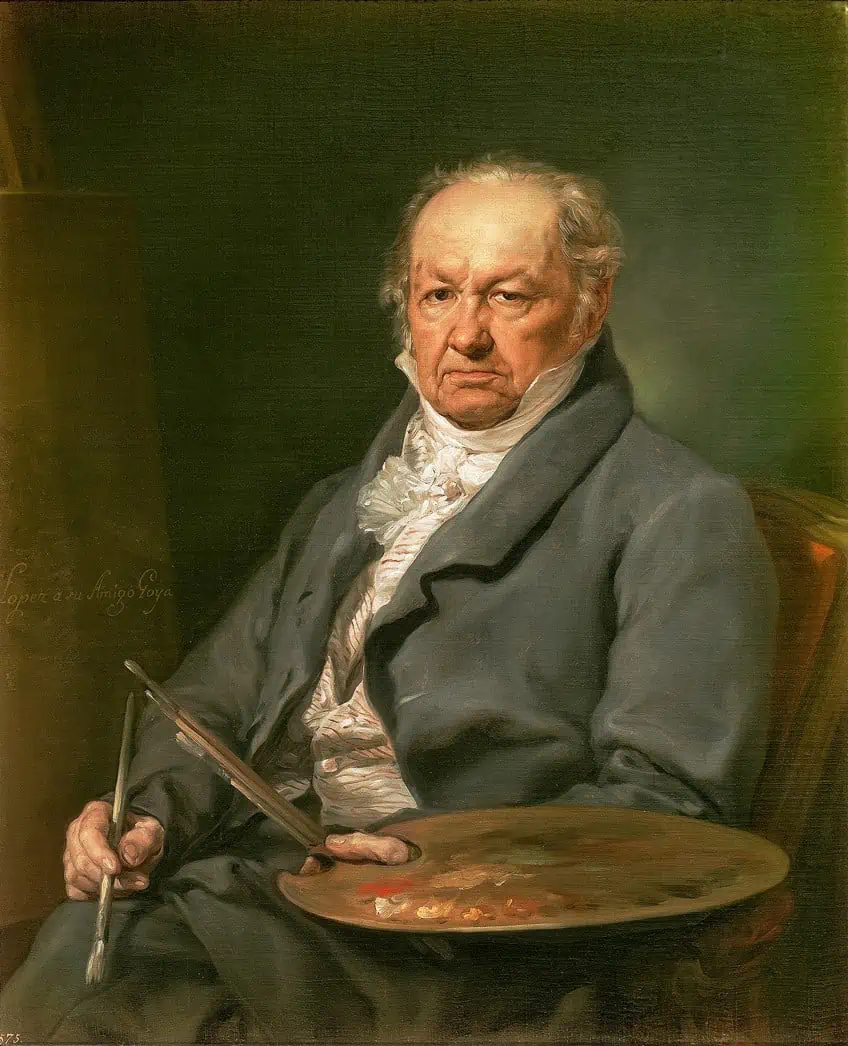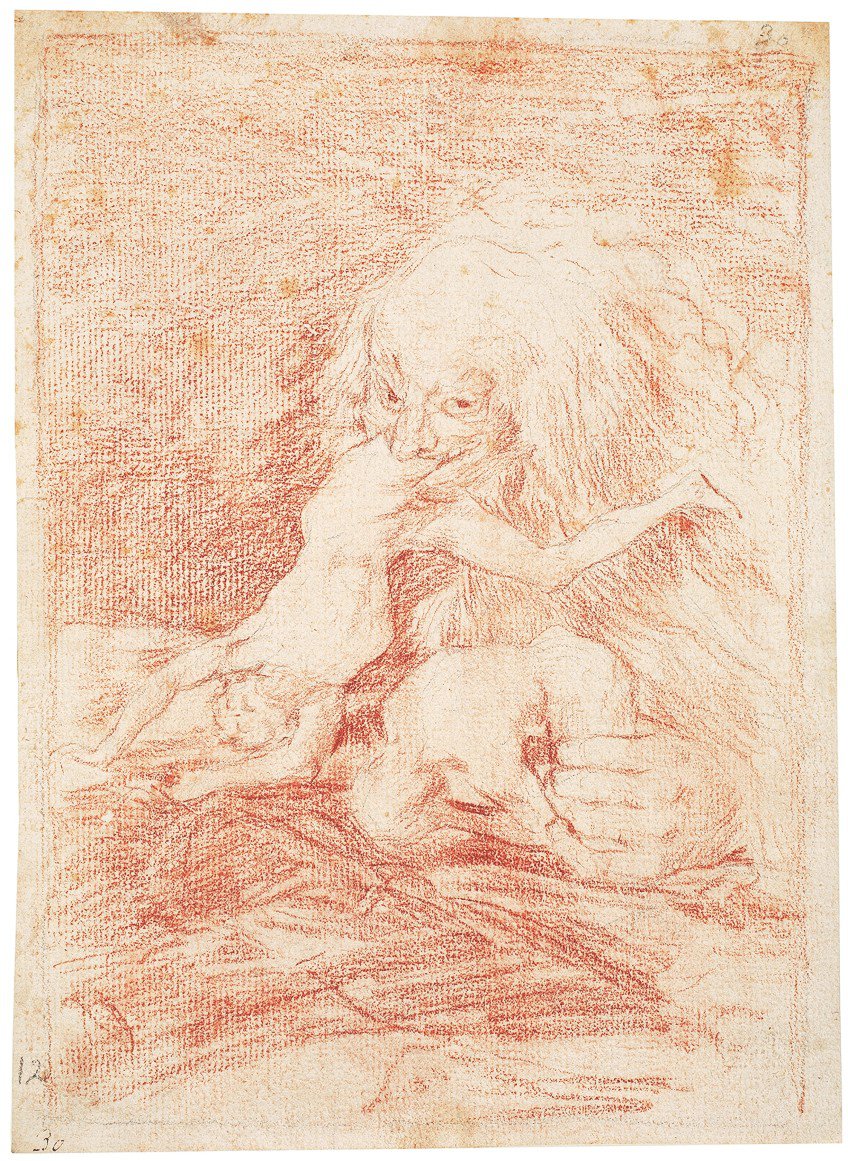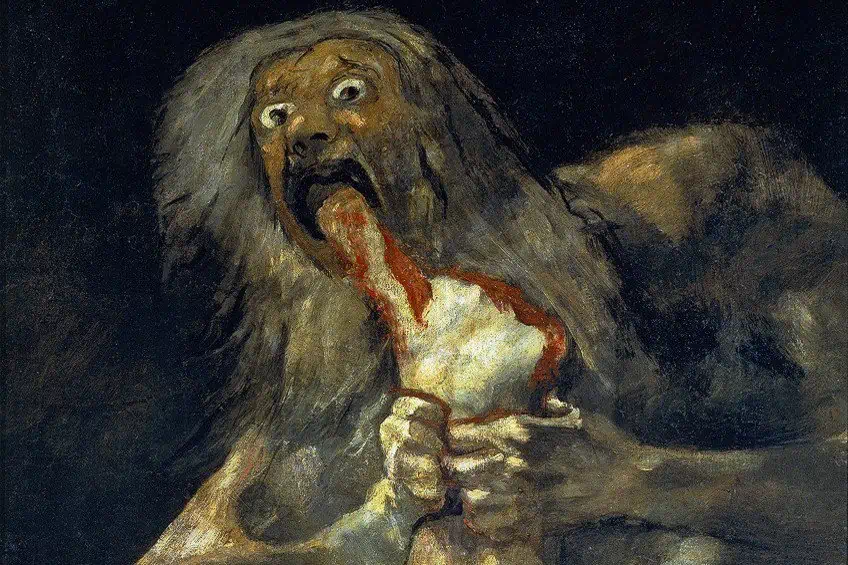“Saturn Devouring One of His Sons” by Francisco Goya – A Look
Saturn Devouring One of His Sons by Francisco Goya, also known as Saturno Devorando a su hijo, is one of the artist’s Black Paintings. Goya was part of the Romanticism movement and the Saturn Devouring His Son painting has a remarkably dark atmosphere to it. The first question you might ask when seeing this painting is, “why did Saturn devour his son to begin with?”. To find out what the answer is to this, and other relevant questions, carry on reading below.
Contents
An Analysis of Saturn Devouring One of His Sons by Francisco Goya
| Artist Full Name | Francisco José de Goya y Lucientes (1746 – 1828) |
| Date Completed | 1821 – 1823 |
| Medium | Mixed media mural transferred to canvas |
| Dimensions (cm) | 143 x 81 |
| Location | Museo del Prado, Madrid, Spain |
This Saturn Devouring his Son painting, which was produced on the plaster walls of Goya’s home at the time, is part of his Black Paintings series. These works were not commissioned by anyone and it is believed that the artist never intended for these works to be publicly exhibited. Some viewed these works as an indication of artistic insanity, whereas others viewed them as a personal expression of resentment to society at large.
It has been theorized that the work was meant to be politically symbolic, with Saturn representing the oppressors and the son representing the people of Spain.
Background of the Black Paintings
While Goya’s Black painting frescoes, such as the Saturn Devouring His Son painting, are a renowned part of his extensive oeuvre, they are very distinct from his earlier works. In fact, he was most well-known early in his career for his lively and vibrant works, which portrayed a much brighter outlook on life. However, his body of works spanned many genres throughout his career, even serving as a court painter, where he produced portraits of royalty.
He subsequently also produced several important political works, such as The Third of May 1808 (1814). Goya also produced several works of a darker tone towards the later part of his career, such as Yard with Lunatics (c. 1794), and the Madhouse (1819).
Goya bought Quinta del Sordo, a home outside Madrid, in 1819. Sometime between 1819 and 1823, before he left this home to relocate to Bordeaux, he created a series of 14 artworks on the house’s walls. Because he was incredibly secretive during this period, there is virtually little evidence concerning this phase of his life. Goya was already in his early 70s, and his health was deteriorating. He had also endured two serious illnesses at this time; he had also gone deaf after getting a fever and was terrified about his own approaching death. It’s apparent that his psychological state was one of dread, both of his own mortality and of the future of Spain.

Inspiring artworks once covered these walls, yet over time, Goya painted over the walls with what would come to be known as his dark “Black Paintings”. Goya expanded the kitchen and began overpainting the existing paintings. What’s interesting is that he included parts of the original landscapes in his Black Paintings. Six of these paintings were produced in his dining room, one of which was the Saturn devouring his own son painting. This is a considerably dark subject matter, especially for a dining room area, yet some would argue that it is somehow fitting, seeing that Saturn is engaged in eating something, albeit his son.
When Goya died, he gave the home to his grandson Mariano, and his successors considerably extended it. It was finally dismantled in 1909 after the city of Madrid had already spread into this region.
In 1874, the mansion was sold to a Belgian aristocrat named Baron Emile d’Erlanger, by which time the paintings had already faded severely. He commissioned a Spanish art restorer called Salvador Martnez Cubells to transfer the delicate paintings onto canvases. After exhibiting the Black Paintings at the Exposition Universelle in Paris in 1878, d’Erlanger subsequently gifted the works to the Spanish state.

Because of the detrimental impact of time on the paintings, as well as the inescapable damage brought about by the sensitive process of mounting brittle plaster onto canvas, the majority of the paintings needed significant restoration, and some particular details may have been lost, but the Saturn Devouring His Son painting seems to have fared far better than some of the other works. The artwork is currently housed at the Museo del Prado in Madrid, Spain. But, why did Saturn devour his son in the ancient Roman myth anyway? Let’s find out in the next chapter.
The Story of Saturn Devouring His Son
Saturn is the Roman name given to the ancient Greek god Cronus. When he was younger, Cronus was aided by his mother in overthrowing his father, Uranus. Yet, his own position as the main god was suddenly at risk when he learned of a prophecy that stated that one of his own children would one day overthrow him. In order to stop the prophecy from ever coming true, Saturn ended up eating all of his own children.
The only one of his offspring to be spared this fate was Jupiter, who would go on to release his siblings in adulthood. It’s a rather dark story and a fitting theme for Goya’s Black Paintings.
Composition
In this artwork, the artist depicts a massive figure dining on an individual, with the head and a portion of the left arm already devoured. The person’s right arm has most likely been devoured as well, however, it might be tucked in front of the son and kept in place by the huge being’s thumbs. Saturn is about to take another bite off the left arm, his eyes bulging and his mouth agape. The only light parts in the painting are the white skin, the scarlet blood of the dead body, and Saturn’s whitened knuckles as he clasps the body with his hands.
A persistent rumor around the artwork is that when it was discovered Saturn was depicted as being sexually aroused as he ate the infant.

Yet, this has not been proven, and no such thing has been observed subsequently owing to the degradation of the plaster. It is also highly plausible that, if arousal was present in the work of art, it was purposefully changed before being displayed in public, especially given that the artist had no intention for this or any of the Black Paintings to be exhibited to the general public. Overall, this artwork and the other Black Paintings mark a dramatic turn away from his earlier works that were produced in a more traditional style.
According to certain views, these paintings illustrate Goya’s exploration of new modes of expression as well as his rejection of established aesthetic rules.
Interpretations
Several interpretations of the painting’s meaning have been proposed by various historians and scholars. According to certain interpretations, the artwork is a political statement on the destructive nature of oppressive authority and how it devours its own populace. Another interpretation is that time is the devourer of all things, a battle between youth and aging. Saturn, the god of time in Roman mythology, is seen devouring his own son, symbolizing the belief that time consumes all things, including life itself. There have been theories based on Xavier, Goya’s own son, and the only one of his six children to live long enough to become an adult.
Others have simply dismissed the works as indications of madness. Although, the work itself could simply be a portrayal of madness instead of reflecting the artist’s own state of mind.
The figure in the artwork itself seems to be mad, which is a very different depiction of Saturn when compared to the calculated actions of the god in the painting of the same theme titled Saturn by Rubens. This Saturn is portrayed out walking, his foot briefly resting on a boulder, one hand clutching his staff, the other holding what he’s eating – his baby son.

Despite their different depictions of the scene, it is believed that Goya had most likely seen Rubens’ version at some point in his life and was possibly inspired by it. All of these interpretations are merely theories, though, as the artist himself left no notes behind on the meaning of the works. In 1797, Goya created a chalk sketch of the same subject, portraying a figure chewing on one individual’s leg while clutching another individual, but without any of the gory details of the later piece. As Goya himself did not provide his Black Paintings with any titles, it has also been suggested that this painting might not depict Saturn at all.
For one thing, none of the god’s usual attributes are present in the painting, such as his hourglass or scythe. The other issue is that Saturn ate his children when they were infants and the person portrayed looks much closer in size and anatomy to an adult human.
Others have suggested that the person being consumed may actually be a female. Given the legs and curvy buttocks, the person appears to be an adult woman. Furthermore, in the other variations, the sons are alive and suffering, or at the very least have heads, allowing the audience to connect with or sympathize with them. As with all the other Black Paintings, one cannot read too much into the titles beyond what someone other than the artist interpreted them as. Furthermore, the process of trying to give the black paintings titles is seen by some as a futile attempt to apply logic to images that compel one to consider chaos and emptiness, a key topic in these works.
Significance
Goya’s Black Paintings represent a significant break from his earlier, traditional paintings and mark a transition into a more contemplative and experimental era of his art style. They are believed to portray Goya’s inner demons because it was painted during a time of immense personal anguish and illness for the artist. This specific painting in the series could potentially be considered a commentary on the darkest parts of the human psyche. The ancient myth of a parent devouring his own offspring raises concerns regarding power and cruelty.
It has been viewed as an illustration of the evils of political tyranny and society’s tendency towards violence. This painting’s raw and deep emotion, as well as its horrific imagery, broke the traditions of his time.

It anticipated the Romanticism and Expressionist movements, which placed significant emphasis on emotional expression and individualism. Its uncomfortable and perplexing characteristics beg for further interpretation and investigation and continue to influence modern scholars and artists. It has sparked several debates and theories on the human condition, death, and our propensity for violence as a species.
Francisco Goya is widely regarded as one of the most influential painters of the late 18th and early 19th centuries, and is best known for his works of art illustrating scenes of governmental corruption and social injustice. Yet, towards the end of his life, he began producing a series of paintings on the walls of his home which were aptly titled his Black Paintings. Saturn Devouring One of His Sons by Francisco Goya, also known as Saturno Devorando a su hijo, is perhaps one of the most well-known of these works. Today, this work is the topic of much discussion, yet, ironically, the artist had no intention for them to ever be seen by the public eye.
Frequently Asked Questions
Why Did Saturn Devour His Son?
Saturn was a Roman god who had taken his place on the throne after toppling his own father, Uranus. However, he was later informed by an oracle that he too would one day be dethroned by one of his own siblings. This terrified the great god, who set about eating all of his offspring as soon as they were born. However, his wife managed to hide one of the children, Jupiter, who would subsequently release all of his siblings from their father’s belly when he became an adult.
Why Did Goya Produce the Saturn Devouring His Own Son Painting?
Goya bought a home known as Quinta del Sordo in 1819. Before he moved out of the house, he painted a series of darkly-themed artworks on the house’s walls. One of these works was the Saturn Devouring His Son painting. While it is believed to be based on the ancient Roman myth about Saturn eating his children, many believe that it is symbolic of the political turmoil that was occurring in Spain at the time, with Saturn representing the country’s oppressors, while the person being eaten represents the people of Spain.
Jordan Anthony is a Cape Town-based film photographer, curator, and arts writer. She holds a Bachelor of Art in Fine Arts from the University of the Witwatersrand, Johannesburg, where she explored themes like healing, identity, dreams, and intuitive creation in her Contemporary art practice. Jordan has collaborated with various local art institutions, including the KZNSA Gallery in Durban, the Turbine Art Fair, and the Wits Art Museum. Her photography focuses on abstract color manipulations, portraiture, candid shots, and urban landscapes. She’s intrigued by philosophy, memory, and esotericism, drawing inspiration from Surrealism, Fluxus, and ancient civilizations, as well as childhood influences and found objects. Jordan is working for artfilemagazine since 2022 and writes blog posts about art history and photography.
Learn more about Jordan Anthony and about us.
Cite this Article
Jordan, Anthony, ““Saturn Devouring One of His Sons” by Francisco Goya – A Look.” artfilemagazine – Your Online Art Source. November 1, 2023. URL: https://artfilemagazine.com/saturn-devouring-one-of-his-sons-by-francisco-goya/
Anthony, J. (2023, 1 November). “Saturn Devouring One of His Sons” by Francisco Goya – A Look. artfilemagazine – Your Online Art Source. https://artfilemagazine.com/saturn-devouring-one-of-his-sons-by-francisco-goya/
Anthony, Jordan. ““Saturn Devouring One of His Sons” by Francisco Goya – A Look.” artfilemagazine – Your Online Art Source, November 1, 2023. https://artfilemagazine.com/saturn-devouring-one-of-his-sons-by-francisco-goya/.



